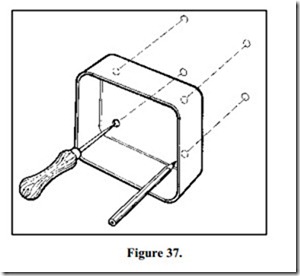Method of Fixing into Wood
First decide on the position of fixtures. Then take measurements off the walls, ceiling or floor. Use the same base line (datum line) each time. For repetitive fixing, a measuring rod may be more efficient. Using the fixture itself, or a template, clearly mark out the position of the holes using a pencil or a bradawl as shown in Figure 37.
Make a hole in the wood, for one woodscrew, using the bradawl. The hole should be about half the depth by which the woodscrew must enter the wood. As a general guide the woodscrew should enter the wood a distance equal to 5 times its thread diameter. Select the correct type and size of woodscrew. Note the surface finish on the fixture at the fixing point. Where a recess is provided, use a countersunk screw, if not use a round head screw. Check the diameter of the hole in the fixture and select a screw having a diameter equal to or slightly less than this. Drive the woodscrew into the prepared hole (preferably an uppermost hole) and allow the fixture to hang from this screw. The fixture can now be aligned accurately. Each remaining hole can be checked and started using the bradawl. The screws can be inserted and driven home. Finally tighten the first screw and check that the fixture is secure.
N.B. Do not overtighten screws particularly when securing hard plastics as these may crack easily.
When driving screws into hard woods it is advisable to drill a pilot hole which should be 2 mm less than the diameter of the screw thread.
Related posts:
The Essentials of Computer Organization and Architecture - Alternative Architectures
Multicore Cables and Cabletray:NYM-J Cables
2.2. CONSTRUCTION ASPECTS OF LINEAR INDUCTION MOTORS
D.C.GENERATORS:Generator Principle
Electric Motor Manual – INSTALLATION METHODS – Checking capacitor motors
Loudspeakers:Soft Domes
ELECTRIC MOTORS:TORQUE PRODUCTION
Connections and Operation of the Thermal Protective Device
The Amortisseur Winding
Alternators:Damper Windings
Transformers:Electromagnetic induction
VARIABLE-SPEED DRIVES:REGENERATION
CONVENTIONAL D.C. MOTORS:TRANSIENT BEHAVIOUR – CURRENT SURGES
SYNCHRONOUS GENERATORS:SYNCHRONOUS GENERATOR CAPABILITY CURVES
